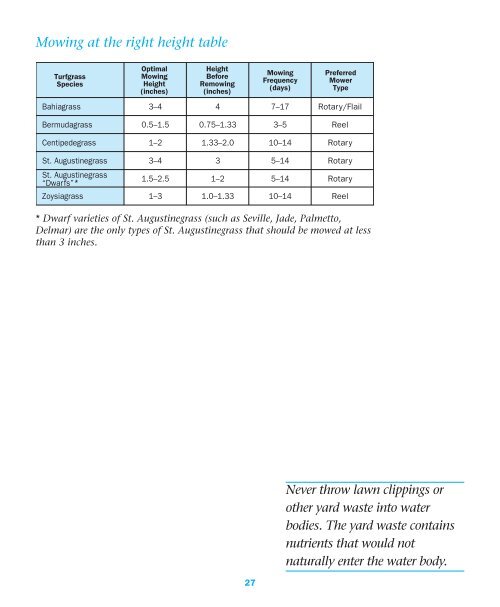What You Need to Know About Fertilizing and Watering - Southwest ...
What You Need to Know About Fertilizing and Watering - Southwest ...
What You Need to Know About Fertilizing and Watering - Southwest ...
Create successful ePaper yourself
Turn your PDF publications into a flip-book with our unique Google optimized e-Paper software.
Mowing at the right height table<br />
Turfgrass<br />
Species<br />
Optimal<br />
Mowing<br />
Height<br />
(inches)<br />
Height<br />
Before<br />
Remowing<br />
(inches)<br />
Mowing<br />
Frequency<br />
(days)<br />
Preferred<br />
Mower<br />
Type<br />
Bahiagrass<br />
3–4<br />
4<br />
7–17<br />
Rotary/Flail<br />
Bermudagrass<br />
0.5–1.5<br />
0.75–1.33<br />
3–5<br />
Reel<br />
Centipedegrass<br />
1–2<br />
1.33–2.0<br />
10–14<br />
Rotary<br />
St. Augustinegrass<br />
St. Augustinegrass<br />
“Dwarfs”*<br />
3–4<br />
1.5–2.5<br />
* Dwarf varieties of St. Augustinegrass (such as Seville, Jade, Palmet<strong>to</strong>,<br />
Delmar) are the only types of St. Augustinegrass that should be mowed at less<br />
than 3 inches.<br />
3<br />
1–2<br />
5–14<br />
5–14<br />
Rotary<br />
Rotary<br />
Zoysiagrass 1–3 1.0–1.33 10–14 Reel<br />
27<br />
Never throw lawn clippings or<br />
other yard waste in<strong>to</strong> water<br />
bodies. The yard waste contains<br />
nutrients that would not<br />
naturally enter the water body.
















